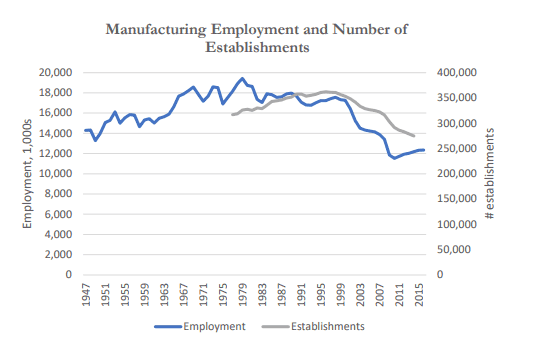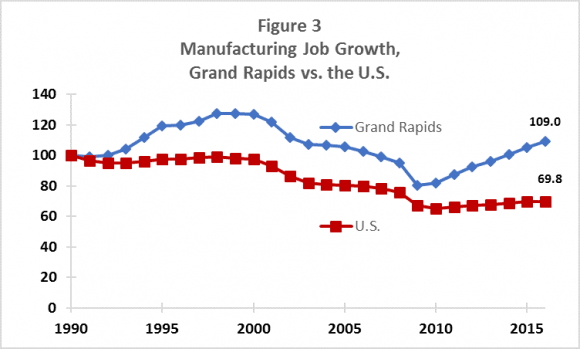There are a variety of opinions and charts relative the declines in US manufacturing, but in general the differences are of ones of degree, not overall direction.
Supply Chain Digest Says... |
 |
| Essential, Bartik says, is stabilizing US manufacturing jobs at something near to 2018 levels – in other words, stopping the bleeding. |
 |
What do you say? |
| Click here to send us your comments |
 |
| Click here to see reader feedback |
|
|
Interestingly, a recent chart from Susan Houseman from the Upjohn Institute shows how declines in manufacturing employment in the US have closely paralleled similar declines in the number of US factories since the year 2000. (See below.)
Now whether the decline in employment and manufacturing establishments is more related to automation and resulting increases in productivity – meaning not as many factors and workers are needed for a given level of manufacturing output – or the result of ruinous price competition from China and perhaps other low cost countries is still of some debate – though it seems clear both factors are in play.
China, by the way, joined the World Trade Organization in 2001.
While this and other data look at US manufacturing as a whole, the reality is that some cities and regional areas have survived the changes better than others and in some cases even prospered – while most areas saw much more negative results.
Why? That is the question economist Tim Bartik recently wrote an new paper published by the Center on Budget and Policy Priorities Full Employment Project called "Helping Manufacturing-Intensive Communities: What Works?"

Source: Upjohn Institute
Bartik looked 105 local US labor markets with populations over 200,000 and that also had above-average shares of manufacturing jobs. That analysis found that just 22 such cities managed to do well, adding private sector jobs and beating the national employment growth rate from 2007 through 2015.
This is important for several reasons, not the least of which is that in aggregate "manufacturing intensive" areas have fared much worse that the average US city since 2000, with jobs losses of 2.5% versus gains of 8.5% from 2000-2015 for non-manufacturing intensive markets.
Yet, about 20% of markets were able to buck the negative trend, at least partially. In some cases, net new manufacturing jobs were created. In other cases, the manufacturing job losses were simply far less than in the average market, while overall jobs in the area grew.
(Article Continued Below)
|
CATEGORY SPONSOR: SOFTEON |
|
|
| |
|
|
Grand Rapids, MI provides an interesting example. As shown in the
chart below, while the area did in fact see a significant loss of manufacturing jobs in 2000-2009, since then gains in such jobs have been much faster than the US overall, about back now to 1990 levels.

Source: Tim Bartik
Bartik's analysis identified three common strategies of the 22 successful areas, as follows:
1. Expand customized services to small and medium-sized manufacturers: Manufacturing can be cost-effectively promoted by manufacturing extension services and customized job training. Manufacturing extension services provide individual firms with lower-cost access to high-quality advice on improving competitiveness. Customized job-training programs provide worker training specific to the firm's skill needs.
2. Invest in infrastructure and services that make the community's land better for business development: Job growth can be cost-effectively promoted by improving services in distressed neighborhoods, cleaning up brownfields, and investing in transportation infrastructure.
3. Increase public spending on services that increase local workers' job skills: Better skills for local workers help attract and grow higher-wage jobs. Adult skills can be improved by programs from birth onward. Effective skills development programs include the following: high-quality child care, high-quality preschool, K-12 education, college scholarships, and adult job training.
Interestingly, Bartik found little evidence that reducing local taxes had much impact on manufacturing job creation. In fact, he wrote in the paper that "I find no evidence that job growth in these areas is significantly spurred by cutting business taxes or increasing business tax incentives."
Contrast that with investment in training.
"Communities experience stronger job growth in states that invest more in customized job training programs, all else being the same. Customized training programs provide free or reduced-cost training, typically delivered by community colleges, that meets the specific skill needs of an individual firm seeking to hire new workers or upgrade its existing workforce."
In the end, Bartik is modestly bullish on the future of US manufacturing, noting that due to trends such as increased customization of products, rising costs in other countries, and macroeconomic policies that make exchange rates more favorable, some manufacturing may move to US markets.
Essential, Bartik says, is stabilizing US manufacturing jobs at something near to 2018 levels – in other words, stopping the bleeding.
Any reaction to these recommendations of what regions can do to promote manufacturing job gains? Let us know your thoughts at the Feedback section below.
Your Comments/Feedback
|
|
Tim Stephens
National Logistics & Sales Director , MGI |
Posted on: May, 30 2018 |
|
While some of your comments and analysis I agree with, I must say that economics has played a major role. We must never forget that the only way we win in manufacturing is to keep building plants in our local communities with the specific education for those positions that become opportunities going forward. Manufacturing takes a skill set that without the proper education relative to that job makes no sense. Most HR Managers hire based off of the wrong factors, therefore these positions will need to focus on those individuals who can carry out those jobs. We need to tell Washington, D.C. to stay out of trucking as well. Only truck drivers know what their limitations are
and standard of driving will be, not Washington, D.C. Anything that I have experienced over my 50 years is that Washington, D.C. only messes up trucking and if they are not careful U.S. Commerce is going to come to a halt. Manufacturing, retailers and trucking will have such a backlog that the highways will be filled with truckers just waiting to go on duty again. The 14 hour rule makes absolutely no sense with regards to families, and the trucking industry as a whole needs to start realizing that. The senator from Texas has tried his best to explain the difficulties that drivers face today but know one is listening.
|
|
|